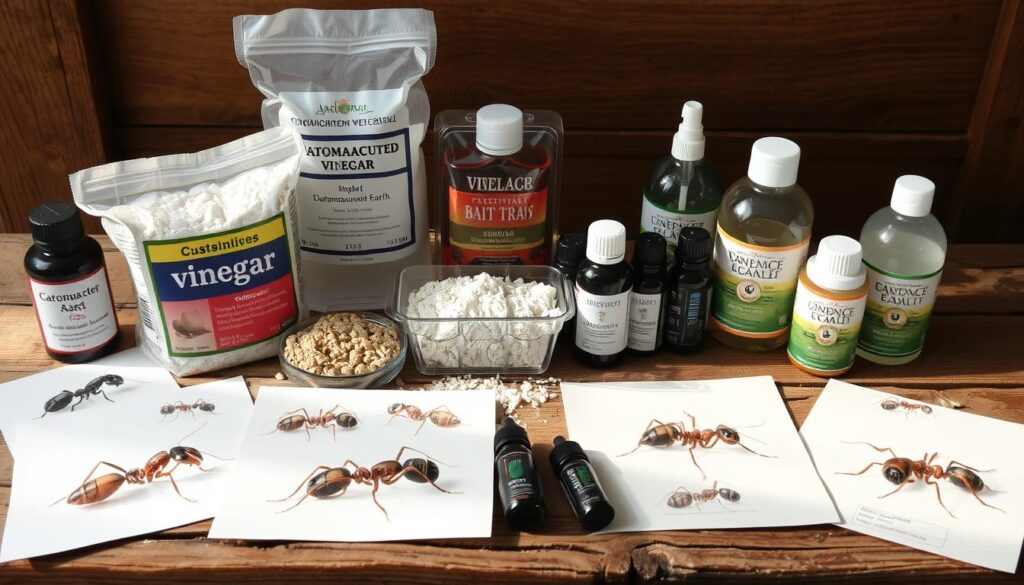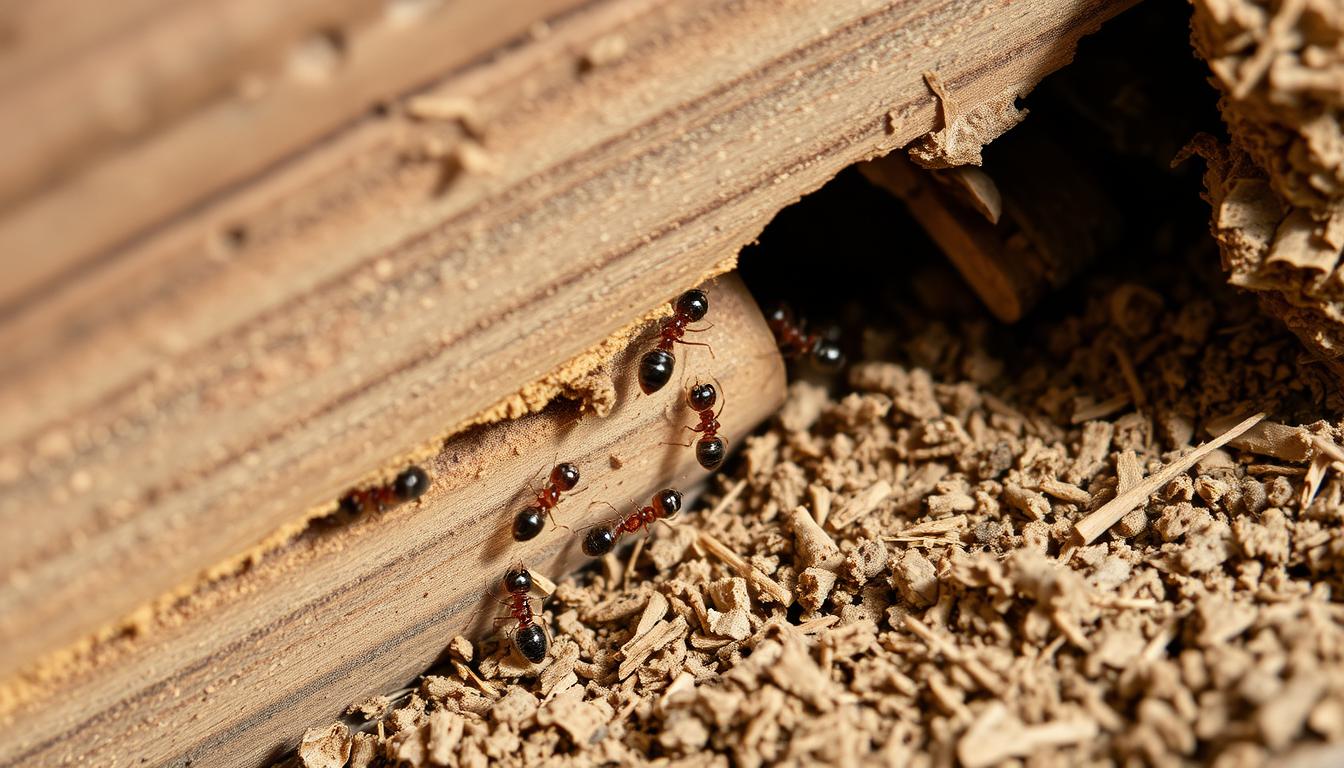Carpenter ants can be a big problem for homes in the United States. They make detailed tunnels in wood, which can weaken your house. Unlike termites, carpenter ants don’t eat wood. Instead, they dig it to make big nests.
Knowing how to control carpenter ants is key for homeowners. These ants come in all sizes, from tiny workers to big ones up to 5/8-inch long. They love moist, wooden places, especially in the Pacific Northwest and Northeast.
Spotting carpenter ants early can save your home from serious damage. This guide will teach you how to spot them and how to get rid of them. You’ll learn how to protect your home from these pests.
Key Takeaways
- Carpenter ants excavate wood but do not eat it
- Different ant sizes indicate a complex colony structure
- Moisture problems attract carpenter ants
- Early detection prevents extensive home damage
- Professional pest control offers the most effective solution
- Regular home maintenance helps prevent infestations
Understanding Carpenter Ant Infestations
Carpenter ants are fascinating but destructive insects. They are a big threat to homes in North America. These large ants can cause a lot of damage if not stopped.
What Are Carpenter Ants
Carpenter ants are among the largest ants in North America. They are 1/4 to 3/4 inch long. The black carpenter ant is well-known for its shiny black color and size.
- Size ranges from 1/4 to 3/4 inch
- Primarily black in color
- Prefer damp and soft wood for nesting
Why They’re a Threat to Your Home
Carpenter ant damage can be very bad for homeowners. Unlike termites, they don’t eat wood but make tunnels. This can weaken your home’s structure. A single colony can make many satellite nests, spreading in your home’s wood.
“Up to 20% of homes may experience carpenter ant infestations at least once in their lifetime.” – Pest Control Research
Common Species in the United States
| Species Name | Color | Typical Habitat |
|---|---|---|
| Camponotus pennsylvanicus | Black | Eastern United States |
| Camponotus modoc | Dark brown | Western United States |
| Camponotus vicinus | Reddish-brown | Southwest regions |
Knowing how to identify carpenter ants is key to catching them early. They are most active in spring and summer. They look for moisture and sweet foods. Homeowners should watch for signs like sawdust-like debris and discarded wings near where they might nest.
Identifying Carpenter Ants vs Other Insects
Identifying carpenter ants can be challenging for homeowners. These pests have unique features that make them stand out. Knowing how to tell carpenter ants from other pests is key to managing them well.
When comparing carpenter ants to termites, several differences are clear:
- Body Shape: Carpenter ants have tapered waists, while termites are more squatted
- Antennae: Carpenter ants have bent antennae, unlike termites’ straight ones
- Size: Carpenter ants are between 1/2 to 5/8 inches long
“A single carpenter ant inside your home could indicate a potential colony nearby” – Pest Control Expert
Physical traits help spot carpenter ants from other species. Unlike black ants, which are much smaller, carpenter ants are larger. They also have wings during reproductive times, a trait black ants lack.
| Characteristic | Carpenter Ants | Termites | Black Ants |
|---|---|---|---|
| Average Size | 1/2 – 5/8 inches | 1/4 – 1/2 inches | 1/16 inches |
| Waist Shape | Pronounced, tapered | Broad, squatted | Narrow |
| Wood Interaction | Create nests, do not eat wood | Consume wood | No wood interaction |
Understanding these differences helps homeowners spot carpenter ant infestations early. This knowledge allows for quick action to address the problem.
Signs of Carpenter Ant Activity in Your Home
Finding carpenter ants early can save you a lot of money and time. These insects leave clear carpenter ant signs that show wood damage in your home.
Visual Indicators of Carpenter Ant Presence
Carpenter ants are big, up to ⅝ of an inch long. Seeing these large ants is a key sign of trouble. Look for these signs:
- Large black or reddish ants moving around your home
- Piles of wood shavings near baseboards or windowsills
- Shed wings near windows or entry points
Structural Damage Signals
Wood damage from carpenter ants can be serious. Unlike termites, these ants tunnel through moist wood. Professional inspections can spot structural problems.
“Carpenter ants don’t eat wood, but they can weaken your home’s structure through tunneling.” – Pest Control Expert
Behavioral Patterns to Watch
Carpenter ant colonies can have up to 20,000 worker ants. Watch for these signs:
- Rustling sounds within walls
- Ants traveling up to 300 feet searching for food
- Increased activity during quiet evening hours
Act fast when you see carpenter ant signs. Early action can save you thousands in repair costs.
Locating Carpenter Ant Nests
Finding a carpenter ant nest needs careful search and strategy. These ants build complex colonies in many places. This makes it hard for homeowners to spot them.
Carpenter ant nests come in two types: parent nests and satellite nests. Knowing the difference is key to getting rid of them.
Key Nest Location Characteristics
- Parent nests have all life stages of carpenter ants
- Satellite nests have mature larvae, pupae, and workers
- Nests like moist, decaying wood
Common Nest Sites
| Indoor Locations | Outdoor Locations |
|---|---|
| Wall voids | Rotting tree stumps |
| Door frames | Woodpiles |
| Around sinks and bathrooms | Fence lines |
Finding a carpenter ant nest takes sharp eyes. Look for frass (wood shavings) near possible entry points. This debris shows tunneling and nest presence.
“Carpenter ants are most active at night, making evening inspections ideal for tracking their movements.” – Pest Control Expert
Tracking Techniques
- Follow ant trails during nighttime
- Check areas with previous water damage
- Inspect wood with soft, compromised structure
- Look for winged ants, which suggest an established nest
Carpenter ant workers can travel up to 300 feet from their nest. This creates complex networks hard to detect. Experts often suggest starting inspections from outside.
How to Get Rid of Carpenter Ants
To get rid of carpenter ants, you need a plan that covers both inside and outside your home. These pests can damage your home’s structure if not stopped. Knowing the best ways to control pests is key to keeping your home safe.
The best way to deal with carpenter ants is to use a detailed plan. This plan should tackle the whole problem.
Indoor Treatment Methods
Controlling carpenter ants inside means finding and getting rid of their nests. Important steps include:
- Looking for damp spots in basements and crawl spaces
- Using dust like diatomaceous earth to target ants
- Setting up slow-acting baits near nests
- Sealing up cracks around windows and doors
Outdoor Treatment Strategies
Outdoor methods help keep carpenter ants away by setting up barriers:
- Trimming plants close to your house
- Removing old wood and debris
- Using safe barriers around your home
- Fixing moisture problems in your yard
Professional Treatment Options
When DIY methods don’t work, experts can help. They use advanced techniques to:
- Find and study ant nests
- Apply strong, lasting insecticides
- Tackle tough infestations
- Give advice on how to prevent future problems
“Effective carpenter ant control requires persistence and a strategic approach to eliminate both visible and hidden colonies.”
Getting help from professionals is important if the problem gets worse or DIY methods don’t solve it.
Natural and Chemical Treatment Options

Dealing with carpenter ants needs a smart plan. You can use natural or chemical ways to get rid of them. This helps keep your home safe and pest-free.
Natural methods are good for the environment:
- Essential oils like citrus and peppermint can harm ants’ breathing
- Diatomaceous earth powder dries out ants’ skin
- Soapy water kills ants right away
- Boiling water can destroy ant nests
Chemical treatments are stronger. Experts say that special chemicals can kill all ants in a colony.
“The key to successful ant control is understanding their behavior and using targeted treatment methods.”
Boric acid is a strong natural chemical. Mixing it with sweet stuff makes a poison that ants will take back to their home. Putting it near ant nests helps get rid of them all.
| Treatment Type | Effectiveness | Application Method |
|---|---|---|
| Essential Oils | Moderate | Direct spray on ant trails |
| Diatomaceous Earth | High | Powder around entry points |
| Boric Acid Baits | Very High | Strategic nest placement |
Remember that keeping an eye on them and using different methods is the best way to control carpenter ants.
Effective Baiting Techniques
To target carpenter ant colonies, you need a smart baiting plan. Knowing how these pests act is key to getting rid of them. Ant baits are a clever way to control carpenter ants by using their social habits.
Types of Ant Baits
Carpenter ants like different foods, so you should use various baits. The best baits include:
- Sugar-based baits for sweet-loving worker ants
- Protein-based baits to attract different colony members
- Liquid and gel formulations for easier transportation
Proper Bait Placement Strategies
Where you place bait stations matters a lot. Experts say to put baits:
- Along known ant trails
- Near potential nesting sites
- Close to entry points in your home
The key to successful carpenter ant control is patience and precise bait placement.
Monitoring Bait Effectiveness
When using ant baits, watch closely. Look for fewer ants and see the colony shrink.
| Bait Type | Active Ingredient | Effectiveness |
|---|---|---|
| Liquid Bait | Borax | High |
| Gel Bait | Fipronil | Very High |
| Solid Bait Stations | Abamectin | Moderate |
Pro tip: Replace bait stations often and be ready to wait weeks for the colony to disappear.
Using Non-Repellent Sprays
Non-repellent sprays are a smart way to fight carpenter ants. They don’t scare ants away like regular sprays do. Instead, they create a hidden barrier that ants can’t see.
These sprays have big benefits:
- Invisible to carpenter ants
- Carried back to the nest by worker ants
- Eliminates entire ant colonies
- Long-lasting protection
Experts suggest using Termidor SC and Phantom for carpenter ants. These products let ants carry the treatment back to their nest. This way, they kill the queen and other nests too.
“Non-repellent products increase colony elimination success by up to 90% compared to traditional pesticide methods.” – Pest Control Research Institute
Here’s how to use non-repellent sprays right:
- Find where ants move most
- Put down thin, steady barriers
- Target where ants might get in
- Avoid leaving chemical marks that ants can see
When using sprays, safety comes first. Wear protective clothes, follow the directions, and keep kids and pets away. Non-repellent sprays work best with a full pest control plan.
Prevention Methods and Home Maintenance
To keep your home safe from carpenter ants, you need a good plan for maintenance and prevention. These pests love certain conditions that can harm your home’s structure.

Stopping ants starts with knowing what draws them to your home. The National Pest Management Association says getting rid of moisture can cut down ant problems by 70%.
Moisture Control Strategies
Carpenter ants love damp places. So, controlling moisture is key. Here are important spots to check:
- Look for water leaks in basements and crawl spaces
- Fix plumbing problems in kitchens and bathrooms
- Make sure areas with a lot of humidity are well-ventilated
- Use dehumidifiers in wet areas
Structural Repairs
To keep ants out, you must take care of your home. Seal up entry points and fix any weak spots:
- Replace rotten wood around windows and doors
- Fix roof edges and trim that are damaged
- Seal small cracks in the foundation
- Clear wood debris from around your home’s base
Landscape Management
Your yard is also important for keeping ants away. Make a safe area around your home:
| Landscape Technique | Ant Prevention Impact |
|---|---|
| Trim trees and shrubs | Blocks ants from getting to your home |
| Remove wood piles | Gets rid of places ants might nest |
| Keep mulch dry | Reduces moisture that ants like |
“An ounce of prevention is worth a pound of cure” – especially when it comes to carpenter ant home maintenance.
Check your home often during warmer months for signs of ants. By following these tips, you can lower the chance of expensive damage.
Common Mistakes to Avoid
Many homeowners make big mistakes when fighting carpenter ants. Knowing these mistakes can save you money and prevent damage to your home.
One big error is using sprays that only kill ants on the surface. These sprays might block ants for a bit but don’t get to the root of the problem. About 70% of carpenter ant problems start from existing holes, making spot treatments usually not enough.
“Killing a few ants is not the same as eliminating an entire infestation.”
- Neglecting moisture control in potential nesting areas
- Ignoring structural vulnerabilities
- Improper wood storage near home foundations
- Leaving pet food outside
Some people think quick fixes will solve long-term pest problems. But it’s important to know carpenter ants often nest in many places to get rid of them for good.
| Common Mistake | Potential Consequences |
|---|---|
| Using Repellent Sprays | Ants scatter, spread colony |
| Ignoring Moisture Issues | Creates ideal nesting conditions |
| Improper Wood Storage | Attracts ant colonies |
Pro tip: Prevention is always more cost-effective than treating extensive damage. Proactive measures can reduce potential repair costs by up to 500%.
When to Call Professional Pest Control
Carpenter ant infestations can quickly become overwhelming for homeowners. It’s important to know when to seek professional extermination to protect your home from damage.
Professional pest control services are crucial in several situations:
- Large-scale infestations covering multiple areas
- Nests located in hard-to-reach structural spaces
- Repeated DIY treatment failures
- Significant wood damage discovered
The average cost for professional ant treatment is between $80 and $500. Initial treatments usually take about two hours for an average-sized home.
“Persistent ant trails often signal a larger colony that requires expert intervention.”
Skilled professionals use advanced techniques to target entire ant colonies. They have access to stronger insecticides and implement comprehensive elimination strategies.
| Infestation Severity | Recommended Action |
|---|---|
| Minor Sightings | DIY Treatment |
| Extensive Damage | Professional Extermination |
| Recurring Infestations | Comprehensive Pest Management |
When choosing a professional extermination service, check their licensing and experience with carpenter ants. Look at their treatment approach. Good professionals will do a detailed inspection, create a targeted treatment plan, and monitor the area to ensure all ants are gone.
Long-Term Prevention Strategies
To keep your home safe from carpenter ants, you need a solid plan. This plan should include many steps to make your home less welcoming to these pests. It’s all about making your home a place they don’t want to be.
Understanding how carpenter ants behave is the first step. Then, you need to set up barriers to stop them from getting in. Keeping up with maintenance is crucial to keep these pests away.
- Seal all potential entry points around windows, doors, and foundations
- Maintain proper moisture control in wooden structures
- Remove decaying wood and tree stumps near your home
- Keep vegetation trimmed and away from house exteriors
“Prevention is always more cost-effective than treating an established carpenter ant infestation.” – Pest Control Experts
Managing moisture is key to keeping ants away. Carpenter ants love damp, rotting wood. So, fixing leaks and improving air flow can help cut down on their favorite spots.
| Prevention Strategy | Effectiveness Rating |
|---|---|
| Regular home inspections | High |
| Sealing exterior cracks | High |
| Moisture control | Very High |
| Landscape management | Medium to High |
Using these methods can help protect your home from carpenter ants. Staying alert and keeping up with maintenance are your strongest defenses. They help prevent damage over time.
Don’t forget about getting help from pest control experts. They can offer extra protection, especially in the spring when ants are most active.
Conclusion
Effective ant management needs a full plan to control carpenter ants. Knowing how these insects behave is key to keeping your home safe. By using a mix of prevention, detection, and treatment, you can fight off carpenter ants.
Success in controlling carpenter ants comes from being proactive and quick. Regular checks, controlling moisture, and sealing holes are important. If DIY methods don’t work, getting help from pest control experts is a good idea.
Keeping your home safe involves more than one step. Find where the ants nest, use the right baits, and keep your home dry. Carpenter ants love damp, rotting wood, so fixing moisture issues is essential. With the right steps, you can keep carpenter ants away and protect your home.
Start using the tips from this guide to fight carpenter ants. Keeping your home safe from ants is a job that needs constant effort. Your hard work will save you from expensive repairs and keep your home free of pests.

